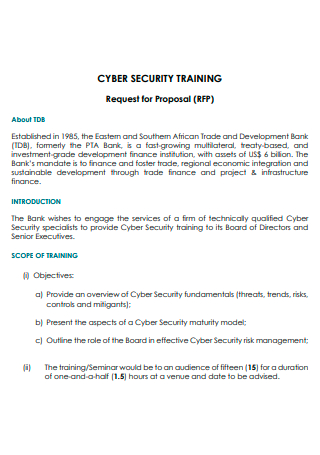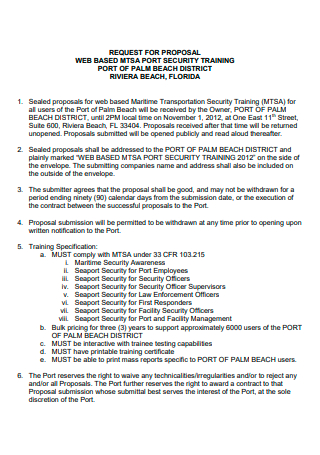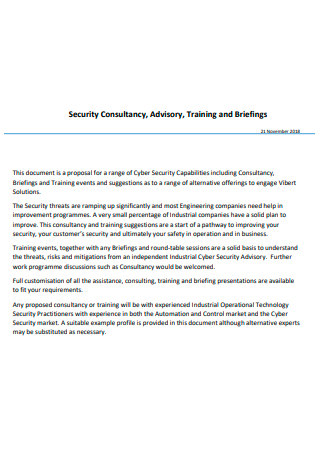3+ Sample Security Training Proposal
FREE Security Training Proposal s to Download
3+ Sample Security Training Proposal
What Is a Security Training Proposal?
Benefits of Security Training
Tips for Creating Employee-Friendly Security Training
How to Improve Your Security Awareness Training
FAQs
How many types of security training are there?
What is the importance of security?
What is in a security plan?
What Is a Security Training Proposal?
IT and security workers utilize security training to prevent and mitigate user risk. These initiatives are intended to help users and workers recognize their role in controlling information security breaches. Practical security awareness training helps employees understand basic cyber hygiene, the security risks associated with their behaviors, and how to recognize email and web-based cyber threats. According to statistics, the average cost of corporate data breaches grew by 15% from the previous year to $3.5 million.
Benefits of Security Training
Research shows that 82% of security breaches involve human error. These facts typically convince individuals that cyber security awareness training is necessary for data protection. Usually, in 2020, only one in nine organizations (11%) provided non-cyber staff with cyber security training or a security awareness program. In the personal sector, however, it is not the case in 30% of businesses. Therefore, many appear unconvinced of the information security benefits of cybersecurity awareness training. Here are seven reasons to rethink:
Tips for Creating Employee-Friendly Security Training
There are numerous types of awareness training. Some opt to host yearly seminars lasting an entire day for the group. Others may send a small number of employees to a training course and then expect them to instruct the rest of the workforce. However, successful cyber security training implementation can be challenging for several reasons. For instance, your team may become bored, they may forget what they have learned, and it is difficult to determine whether the training was practical. In this post, we have distilled our experience in giving awareness training into seven actionable suggestions you may utilize to advance your efforts.
1. Start by gaining the support of your staff
Getting your employees interested in the process is the first step to making a good security awareness training program. Getting your employees on board with the training helps start by explaining why it is essential and not just something to get through quickly so they can cross it off their to-do lists. If your team knows why they are being trained, they will be more committed to improving your organization’s security culture. Also, they will be more likely to remember and use the essential lessons from the training, which is the whole point.
2. Approve the security training for your whole company
The IT department shouldn’t be the only one pushing security training on the staff. The management must support the security awareness training process from beginning to end for it to succeed. Without it, your team may lack the motivation to devote time to awareness training and may be hesitant to complete the courses. Your employees will understand that everyone, not just the security or IT department, is accountable for building a security company if team leaders and management from across your organization support the cybersecurity training. It may also promote open discussion of the training or other security awareness-related subjects.
3. Display both the individual and corporate significance of security awareness
Everyone is more concerned with matters that could affect them directly. This is why we recommend security training programs that educate on the importance of appropriate security practices in personal and professional settings. Personal data breaches can severely affect both employees and the firm, so showing your staff what they risk personally in the event of a data breach may encourage them to take the training more seriously. Addressing the personal aspect of data security can help train your workers to practice good cyber hygiene at home and work. In short, these positive habits will become ingrained in their daily life rather than something they must remember to do at work.
4. Keep it simple
One of our essential strategies for practical security awareness training is to make the material relatable and straightforward to comprehend. Remember that most of your staff lack a technological background and that it is easy to become frustrated by training when every term must be Googled. IT security jargon might further alienate personnel from the field of IT security. If they do not comprehend the threats, they will be unable to protect themselves or the organization. Therefore, you should explain subjects in straightforward, everyday language. This will increase learning and make your employees more enthusiastic about participating in the security training, resulting in the program’s long-term success. Also, recognize that you do not need to teach everything there is to know about a subject in a single lesson. By dividing teachings into small chunks, you may gradually increase your employees’ understanding without overwhelming them with information.
5. Provide it in little portions
There is great value in learning about IT security, from passwords to phishing assaults to GDPR and social engineering. During security awareness training, your staff can’t cover, digest, and recall all of this material. Therefore, information security training should be provided incrementally over an extended period. This will offer your staff time to contemplate, practice, and breathe while keeping IT security on the agenda for ample time. We propose 5 to 10-minute training sessions.
6. Provide relevant material
The security awareness training should apply to every department and employee in your firm. You are not required to provide technical details about how computers operate or to delve thoroughly into information security standards. Develop material that everyone can understand. Learning about IT security should not be a source of anxiety but confidence for your firm. Create enlightening and engaging courses customized to your employees’ needs rather than the IT department. No one should experience boredom during the lessons. One method to accomplish this goal is using contemporary examples to clarify ideas and illustrate how security errors occur.
7. Make it interactive
Adding interactive approaches is a simple way to maintain interest in security awareness training. After a training session, you might give your staff a brief quiz on the course’s essential takeaways. The usage of examinations serves dual purposes: it maintains employee interest in security training and provides a method for assessing their knowledge. Interactive techniques ensure that your staff remains engaged in your cybersecurity training session. The greater your employees’ participation in the learning process, the greater their understanding of their vital role in ensuring your firm’s safety.
How to Improve Your Security Awareness Training
Implementing a security awareness training program may appear daunting, especially in an organization that has never utilized such training. There are various potential topics to discuss and multiple ways to cover them. While there is no “one-size-fits-all” security awareness training program, there are best practices that can help you focus your efforts. If you are interested, the following are some of the actions you can take:
Step 1: Be adaptive to your corporate culture
Not only do enthusiasm and support levels vary from company to company, but also from department to department and management level to management level within the same organization. Instead of mandating security training based on what you believe to be the most successful method, collaborate with senior management and staff to build a strategy that integrates your security awareness program with the current corporate culture.
Step 2: Ensure training covers all organization-specific material
According to 68% of security professionals, data breaches, phishing attacks, and CEO fraud assaults are significant issues. It’s tempting to believe that your staff shares your security worries. Still, it’s far more likely that undertrained employees lack the skills to identify security dangers and a meaningful comprehension of attack implications. A security breach only requires a single oversight, so be sure to concentrate on your worst threats and train for all possible scenarios.
Step 3: Plan phishing scenarios to occur at random times
Only 5% of people who work in security say that phishing and spearphishing are becoming less of a problem in their organization. Your phishing simulation strategies are essential, whether you’re trying to lower your phishing rate or keep your employees’ phishing defenses up to date. Think more about the effectiveness of the simulation than the number of phishing simulations. Schedule phishing simulations randomly so your employees can’t figure out how often you send phishing emails, and you can see how their behavior changes over time.
Step 4: Training frequency is key
If you want people to keep doing the best things for security, you need to keep safety at the top of your mind. The question is, “How often should training happen, and how should it be done?” Even though there is no magic number, the best way to train is in shorter, more frequent bursts. You can automatically deliver training at the best frequency by layering exercises with ongoing phishing simulations and event-activated learning to link activity to actual events.
Step 5: Adapt training to the appropriate groups
The most effective security awareness programs provide the appropriate training to the right individuals at the proper time. This involves providing training specific to your company’s business and the roles of its employees, as well as activating instruction at the most teachable moments. Despite its success, only 27% of security practitioners report implementing a comprehensive security awareness program employing a human firewall strategy. When constructing or enhancing a security awareness program, begin with customized training for the most impact and continue integrating training activities into employees’ daily workflow. This will infuse security into the fiber of your organization and result in genuine behavioral change.
Step 6: Focus on behavioral modification
On average, security experts view technical infrastructure as more practical than security awareness training for preventing security problems. While security awareness training should not replace technical measures, it is essential to remember that they work in tandem, not in isolation. Physical infrastructure stops assaults until an employee receives a phishing email or a targeted attack goes undiscovered. It is essential to view security training in terms of the behavioral change it engenders, as opposed to as a compliance necessity or a philosophical goal. Behavioral change is not simply the ultimate objective of your training, but it is also measurable. Focus on phishing rates, the number of employee-reported emails, and events prevented by endpoint protection to provide data-driven support for your security awareness program.
Step 7: Don’t punish mistakes
On average, security professionals have poor confidence in the capabilities of their staff and senior executives to handle phishing and spearphishing attempts effectively. When trust in employees’ abilities to address security threats is low, it is even more crucial to view security occurrences as learning opportunities rather than as justification for punishment. Instead of encouraging information sharing and security knowledge, penalizing clicks on phishing links might create fear and even shame or secrecy surrounding security events.
FAQs
How many types of security training are there?
There are three forms of training for security guards, each of which consists of various courses. Individuals or security staff will participate in training that applies to the specific location.
What is the importance of security?
Practical and dependable workplace security is crucial for any organization because it decreases insurance, compensation, liabilities, and other expenses that the firm must pay to its stakeholders, resulting in a rise in business revenue and a decrease in operational costs.
What is in a security plan?
A security plan should include daily policies, methods, and protocols for managing various scenarios—incarceration or disappearance, security, security management, etc. The more day-to-day policies and measures are implemented, the greater the effectiveness of situation-specific protocols.
This proposal is a little challenging, especially since it calls for organizing suitable activities to accomplish the desired aims and objectives. However, this is a terrific initiative a company should take with its staff to raise public knowledge of the significance of security and how to respond if security is violated. Start by creating your proposal and presenting it to the relevant authorities.




